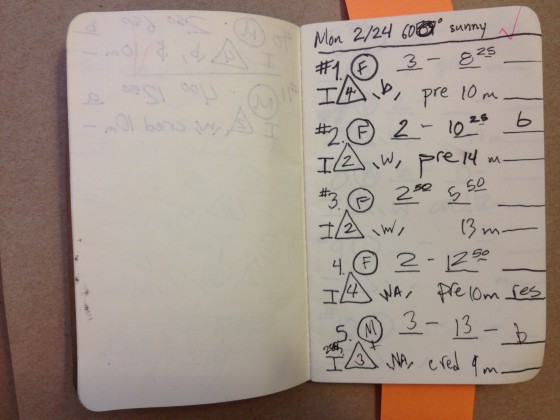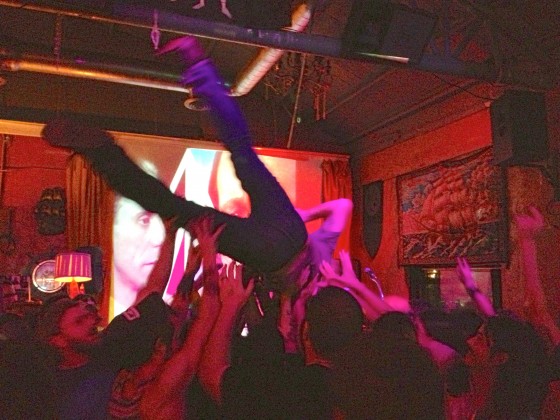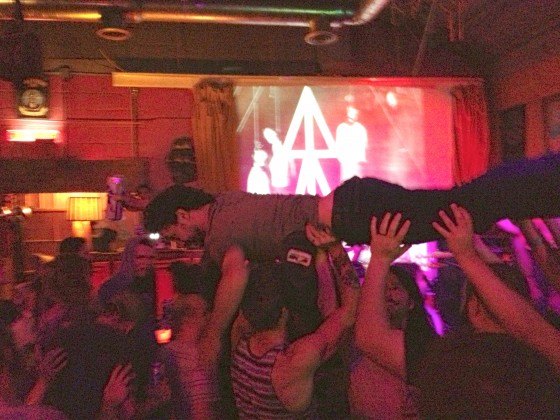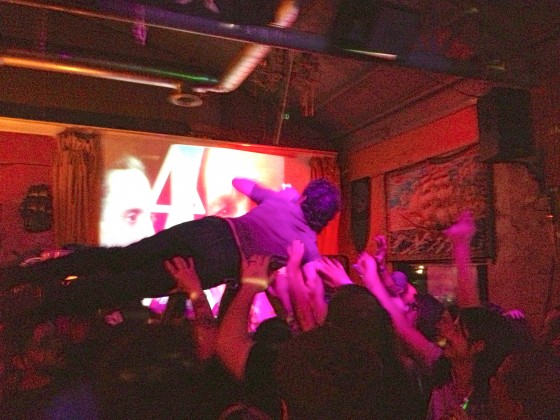A correction: In last week’s story I said Jerry rode for W.A.R. He corrected me, saying he rides for R.A.D. while the others with associations at work ride for W.A.R. I flip-flopped them in my mind. I apologize to my readers and vow to avoid such grave lapses in reporting henceforth.
Ehem.
This article’s project has been in the works for almost as long as this blog. I spent a month in February and March recording all kinds of details about every delivery I made, 268 of them all told. Skip to the next section to see my results.
I wanted to know what went into a customer’s tipping decision: how long they wait, how much they buy, their sex, race, income, or just habit? I was especially intrigued with the paradox of chipper customers who tipped poorly, and of sullen customers who nevertheless tipped me generously.
I paused at front desks, driveways and elevators to scribble observations in a tiny pocket journal. With each entry, I would draw a triangle and rate my customer’s mood on a scale from 1 to 4.
I love the kind of writing and research done by authors like Malcolm Gladwell and the authors of Freakonomics. They use data to understand why people do what they do. This pet research project of mine is one nerdy attempt to teach myself to do the same thing.
I’m not a mathematician. I’m learning as I go; I’m not yet proficient with the nuances of standard deviation, statistical significance or adjustment for multiple factors. These findings are fairly preliminary and don’t stack up to accepted standards of blah, blah, blah… I do think there are a few clear and immediate insights, and I plan to dig deeper. I’d welcome any expert help.
A Typical Delivery
Sometimes people in elevators and office buildings are surprised to learn I’ll deliver for one sandwich. That’s actually the standard. Here’s a snapshot of the average delivery. The average delivery costs $8.88 (although real prices come out to multiples of $.25), contains one sandwich and takes 16.5 minutes to deliver. It earns its driver a tip of $2.71. My average shift, at least during the study, lasted between 3 and 4 hours, during which I ran 13 deliveries.
Here’s what I found about tipping in my job:
Men tip an average of 15% more than women.
The average tip from a male is $2.91, while his female counterpart tips $2.53. Again, this describes the tiny subset of men and women living and working Uptown, and specifically those who order sandwiches for delivery.
Interestingly, men also usually spend about a dollar more per order than women. That equals a can of coke. The exception here is with large orders, where women seem to coordinate more of the lunch meeting catering orders. Women also order almost two sandwiches per delivery, whereas men order fewer than 1.5. Neither sex seems to be any more prone to sandwich cravings than the other. The breakup is almost exactly 50 / 50.
Variance by Race
A FEW DISCLAIMERS: I have been cringing to write this section for fear of accusations of racism, but despite the limitations I think there may be something of value here. While I described several groups by race in my research, blacks and whites were the only groups to show up in large enough numbers to show reliable trends. I’ll include Asians as well, but as there were only 9 in my data set any conclusions should be taken with a grain of salt. I made race determinations visually. Sometimes I wouldn’t see the person at all. I suspect that I tended to describe some mixed-race and latino customers as white. I consider race, along with economic class, to be the least reliable dimensions of my research since they are both incredibly hard to measure with confidence.
Let’s take a look at the data.
Whites averaged $3.10 per tip, Asians, $3 per tip, and blacks averaged $2 per tip.
Again, here it’s important to note that blacks were overrepresented in jobs that appeared to be blue-collar (which I defined as hourly-waged rather than salaried). Blacks were equally likely to be blue- or white-collar workers. Whites, meanwhile, were three times more likely to be white-collar than blue-collar. This brings us to our next point.
White-collar workers tipped 14% more than blue-collar workers. Blue-collar workers tipped an average $2.39. White-collar workers tipped $2.72. Perhaps this isn’t surprising. Maybe what is surprising about this figure is that it isn’t larger, given the huge income disparity amongst our customers.
Interestingly, a large third group of individuals that I labeled “N/A” for class were the most generous tippers, giving $3.01, a full 26% more than blue-collar workers. I have no clue how to explain this. Perhaps these people were too busy to accept their own lunch and had someone else sign for it. In that case, maybe they played executive roles and thus had higher incomes.
This is what’s so fun and so dangerous about statistics: you can read any story you want onto a figure. It’s human nature to seek stories that explain the world, but sometimes we’re overeager and get into trouble. It would be wise, then, to investigate this “executive” hypothesis with further research before propagating any “common sense” narrative for it. Oops, too late.
Wait Time
Our company brands itself for its fast delivery. It turns out that yes, in fact, tips drop off with longer wait times. Deliveries made in under 20 minutes earned tips of 26% of their subtotal price, while longer waits pushed tips down to 22% of subtotals. That’s a 15% drop in tip income between fast and slow deliveries. I’d better get my tushy moving!
Mood matters a little.
The difference in tipping between a low-energy, minimally engaged 2 rating to a personable and positive 3 rating goes along with only a 12% increase in tipping, from $2.54 to $2.84. Tipping actually goes down with the jump to extreme chipperness, with 4’s tipping an average $2.80.
I had only two instances of 1 moods, which I defined as demonstrably angry. Of these, one person gave me a dollar. So one could make the (irrelevant and ridiculous) statement that moving from a 1 to a 2 will increase tipping fivefold.
I broke my wrist halfway through this study. I had a cast on my left hand starting at the beginning of March, and I wondered whether this garnered me any sympathy tips. As it turns out, though, my tips actually dropped about 9%. Go figure.
The real takeaway here is that most of what goes into a tip has little to do with a person’s individual sandwich experience. A tip can be predicted more by factors that were established at birth than anything else. A person’s race, gender, and economic class have a huge effect on their likely tipping practices.
These kinds of findings make me want to work towards a world with better opportunities for the less fortunate. I think poor tipping speaks to poor life opportunities. Tipping is certainly cultural, and so is poverty.
I think it’s particularly important to tackle root causes of problems like generational poverty. That’s why I’m motivated to start asking questions like how we can better equip parents of underprivileged children. Using data can help us get there.








Recent Comments